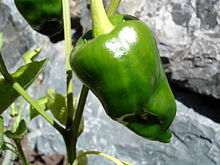- Poblano
-
This article is about the chile pepper originating in Puebla, Mexico. For persons from Puebla, called Poblanos in Spanish, see Puebla. For the political blogger, see Nate Silver.
Poblano Heat Low (SR: 1,000-1,500)  A fresh poblano pepper, often sold north of Mexico and referred to as pasilla
A fresh poblano pepper, often sold north of Mexico and referred to as pasilla
The poblano is a mild chili pepper originating in the State of Puebla, Mexico. Dried, it is called a chile ancho ("wide chile"). The ripened red poblano is significantly hotter and more flavorful than the less ripe, green poblano. While poblanos tend to have a mild flavor, occasionally and unpredictably, they can have significant heat. Different peppers from the same plant have been reported to vary substantially in heat intensity. A closely related variety is the mulato, which is darker in color, sweeter in flavor and softer in texture.
One of the most popular peppers grown in Mexico, the bush (of the species Capsicum annuum) is multi-stemmed and can reach 25 inches in height. The pod is about three to six inches long and about two to three inches wide. An immature poblano is dark purplish green in color, but the mature fruits eventually turn a red so dark as to be nearly black.
Poblanos are grow in zones 10-12 and do best with a soil ph between 7.0 - 8.5. Poblanos typically prefer full sunlight and during harvest in late summer may require additional support for the growing fruits. A poblano takes around 200 days from seed to harvest and require temperatures to be at least 64 degrees F to germinate.[citation needed]
Preparation methods include: dried, coated in whipped egg (capeado) and fried, stuffed, or in mole sauces. It is particularly popular during the Mexican independence festivities as part of a dish called chiles en nogada, which incorporates green, white and red ingredients corresponding to the colors of the Mexican flag. This may be considered one of Mexico's most symbolic dishes by its nationals. It is also usually used in the widely found dish chile relleno. Poblanos are popular in the United States and can be found in grocery stores in the states bordering Mexico and in urban areas.
After being roasted and peeled (which improves the texture by removing the waxy skin), poblano peppers can be preserved by either canning or freezing. Storing them in airtight containers will suffice for several months. When dried, the poblano becomes a broad, flat, heart-shaped pod called an ancho chile (meaning "wide" in Spanish); from this form it is often ground into a powder used for flavoring recipes.
"Poblano" is also the word for an inhabitant of Puebla, and mole poblano refers to the spicy chocolate chili sauce originating in Puebla.
See also
External links
References
Capsicum cultivars C. annuum Aleppo · Anaheim · Ancho · Banana pepper · Bell pepper · Cascabel · Cayenne · Chilaca · Chiltepin · Cubanelle · De árbol · Dundicut · Fresno · Guajillo · Hungarian wax · Italian sweet · Jalapeño · Mirasol · Macho · Mulato · New Mexico (Anaheim) · Paprika · Pasilla · Peperoncini · Peter · Piquín · Pimento · Poblano · Puya · Serrano · Shishito · Tien TsinC. chinense Adjuma · Ají Limo · Ají dulce · Datil · Fatalii · Habanero · Hainan Yellow Lantern Chili · Madame Jeanette · Naga Jolokia · Red Savina Habanero · Scotch bonnetC. frutescens C baccatum C. pubescens Categories:- Chili peppers
- Crops originating from Mexico
- Mexican ingredients
- Food ingredient stubs
- Solanales stubs
- Fruit stubs
- Vegetable stubs
Wikimedia Foundation. 2010.


